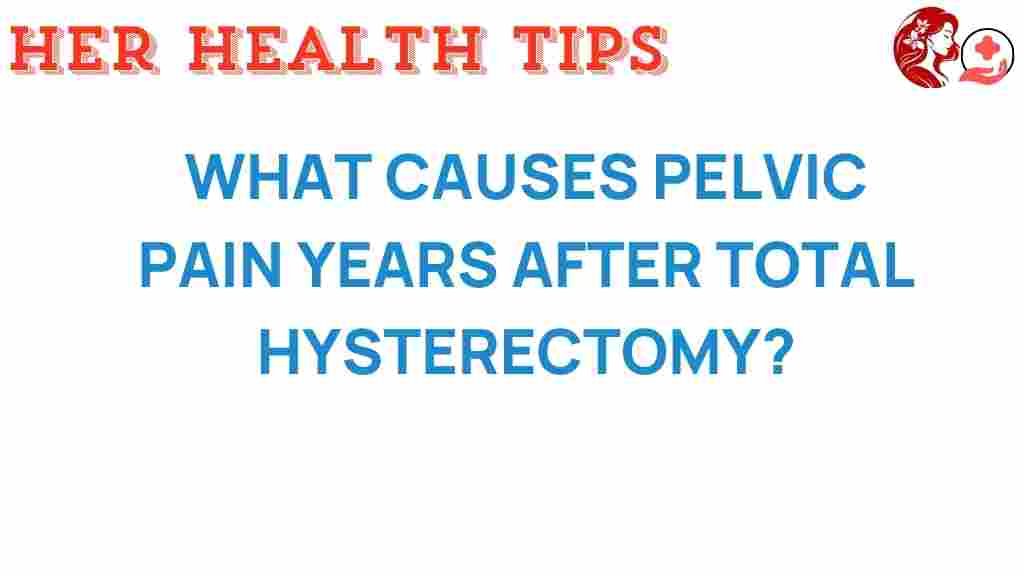Unraveling the Mystery: What Causes Pelvic Pain Years After Hysterectomy?
Pelvic pain is a complex and often misunderstood condition that affects many women, particularly those who have undergone a hysterectomy. While this surgical procedure is commonly performed to address various gynecological issues, it can lead to chronic pain long after the recovery period. Understanding the causes of pelvic pain years after hysterectomy is crucial for women’s health, as it can significantly impact quality of life.
Understanding Hysterectomy and Its Impact
A hysterectomy is the surgical removal of the uterus and, in some cases, surrounding structures. This procedure is often recommended for women suffering from:
- Uterine fibroids
- Endometriosis
- Uterine prolapse
- Cancer of the uterus or cervix
- Chronic pelvic pain
While many women experience relief from their initial symptoms after surgery, others may develop persistent pelvic pain. This chronic pain can stem from various factors, and recognizing them is vital for effective diagnosis and treatment.
Causes of Pelvic Pain After Hysterectomy
Several factors can contribute to pelvic pain years after a hysterectomy. Understanding these causes can help patients and healthcare providers develop appropriate treatment plans.
1. Nerve Damage
During a hysterectomy, nearby nerves may be unintentionally damaged. This nerve damage can lead to chronic pain in the pelvic region, as the nervous system may send pain signals even when there is no injury present.
2. Scar Tissue Formation
After any surgical procedure, scar tissue can form as part of the healing process. This tissue can lead to adhesions, which may cause pain and discomfort in the pelvic area. Adhesions can restrict movement of organs and tissues, leading to chronic pain.
3. Residual Gynecological Issues
In some cases, the underlying gynecological issues that prompted the hysterectomy may not be fully resolved. Conditions like endometriosis or pelvic inflammatory disease can persist, causing ongoing discomfort and pain.
4. Psychological Factors
Chronic pain is often influenced by psychological factors such as anxiety or depression. Women who have undergone a hysterectomy may experience emotional stress related to their surgery and its aftermath, which can exacerbate feelings of pain.
5. Musculoskeletal Issues
Post-surgery, some women may develop musculoskeletal pain due to changes in posture, movement patterns, or physical activity levels. This can lead to tension and discomfort in the pelvic region.
Diagnosis of Pelvic Pain After Hysterectomy
Diagnosing the cause of pelvic pain in women who have had a hysterectomy can be challenging. A comprehensive evaluation is essential for identifying the underlying issues affecting recovery. Here are some steps involved in the diagnostic process:
- Medical History Review: A thorough discussion of the patient’s medical history, including details about the hysterectomy and any ongoing symptoms.
- Physical Examination: A gynecological examination to assess any visible signs of complications or abnormalities.
- Imaging Tests: Ultrasounds, CT scans, or MRIs may be ordered to visualize the pelvic organs and identify any structural issues.
- Referral to Specialists: Patients may be referred to pain specialists, physical therapists, or psychologists for comprehensive care.
Treatment Options for Pelvic Pain
Once the diagnosis is made, various treatment options can be explored to manage pelvic pain effectively:
1. Medications
Over-the-counter pain relievers such as ibuprofen or acetaminophen can be effective for managing mild pain. For more severe pain, doctors may prescribe:
- Opioids
- Antidepressants
- Anticonvulsants
2. Physical Therapy
Pelvic floor physical therapy can help strengthen pelvic muscles, improve flexibility, and relieve pain. A trained physical therapist can guide patients through specific exercises tailored to their needs.
3. Counseling and Support
Psychological support can be beneficial in addressing any emotional factors contributing to chronic pain. Cognitive-behavioral therapy (CBT) and support groups can help women cope with their feelings and improve their overall quality of life.
4. Alternative Therapies
Some women find relief through alternative therapies such as:
- Acupuncture
- Chiropractic care
- Massage therapy
5. Surgery
In cases where pelvic pain is caused by complications such as adhesions or continuing gynecological issues, further surgical intervention may be necessary.
Post-Surgery Recovery and Management
Recovering from a hysterectomy and managing post-surgical pelvic pain requires a multifaceted approach. Here are some essential tips for women undergoing recovery:
- Follow-Up Appointments: Regular check-ups with a healthcare provider are crucial for monitoring recovery and addressing any ongoing symptoms.
- Stay Active: Gradually increasing physical activity can help improve recovery times and reduce pain. Low-impact exercises such as walking or swimming are often recommended.
- Healthy Diet: A nutritious diet can support healing and overall well-being. Foods rich in anti-inflammatory properties can be particularly beneficial.
- Stress Management: Techniques such as yoga, meditation, or mindfulness can help manage stress, which can exacerbate chronic pain.
Troubleshooting Tips for Managing Pelvic Pain
For women experiencing pelvic pain years after a hysterectomy, here are some troubleshooting tips that may help:
- Keep a Pain Diary: Documenting pain levels, triggers, and relief measures can help identify patterns and inform healthcare providers.
- Communicate Openly: Discuss any symptoms or changes in pain with healthcare providers to ensure appropriate adjustments in treatment.
- Explore Support Groups: Connecting with others who have had similar experiences can provide emotional support and practical advice.
Conclusion
Pelvic pain after hysterectomy is a complex issue that can stem from various causes, including nerve damage, scar tissue, residual gynecological issues, psychological factors, and musculoskeletal changes. Understanding these causes is critical for effective diagnosis and treatment, which can include medication, physical therapy, counseling, and alternative therapies.
For women experiencing chronic pelvic pain, it is essential to seek help from healthcare providers who understand the intricacies of women’s health and post-surgery recovery. With the right approach and support, it is possible to manage pain effectively and improve quality of life.
For more information on women’s health issues, visit NCBI Women’s Health or explore pelvic pain management resources at Pelvic Pain Foundation.
This article is in the category Conditions and created by HerHealthTips Team
